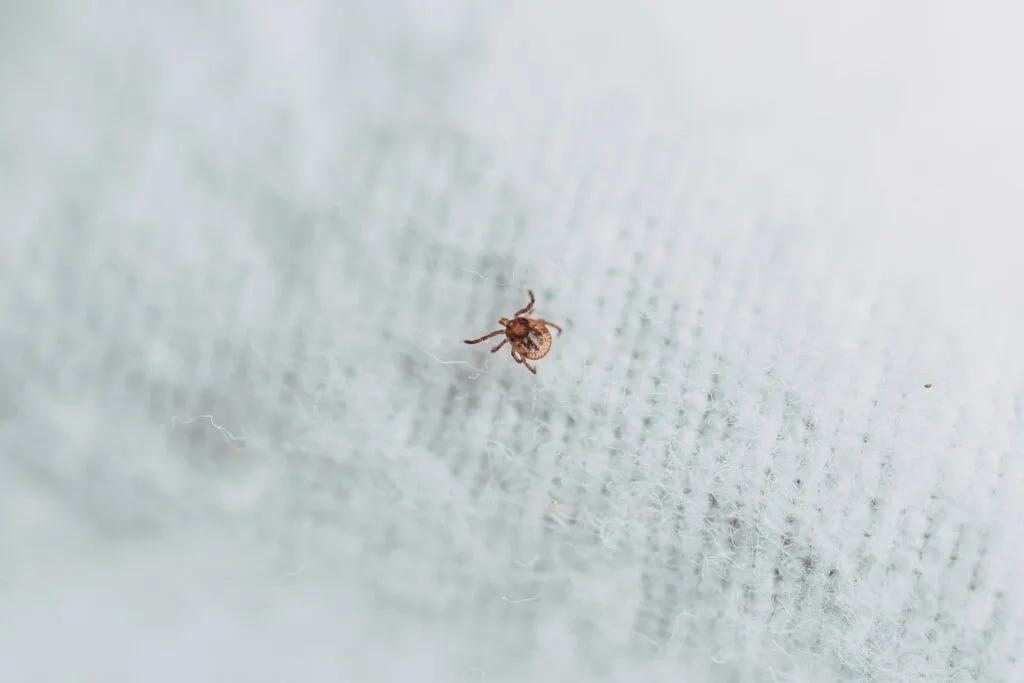The Best Deals on Camping, Backpacking and Outdoor Gear [June 2025]

Ticks are the worst. They can carry diseases like Lyme disease or Alpha-gal, and while they may not be as irritating as mosquitos (like when camping in the Florida Everglades), there’s just something about an insect that sticks it’s head into your skin to feed off of you that’s also difficult to remove that’s totally unsettling. But as much as we hate ticks, we’ll admit that they’re a bit misunderstood and there are plenty of myths about ticks floating around out there. And they definitely shouldn’t keep you from going outside this summer (even if you live in the unofficial tick capital of the U.S. like we do–NW Arkansas).
So we chatted with Dr. Thomas Mather, an expert on all things ticks, Director of the University of Rhode Island Center for Vector-Borne Disease, and Equip-4-Ticks Resource Center collaborator, to dispel some myths, explain how to protect yourself, what insect repellents actually work, and what to do if you do get snacked on.

5 Common Myths About Ticks
Terradrift: So you’re a tick expert, huh? What’s your experience with them?
Dr. Thomas Mather: I joined the University of Rhode Island (URI) in 1992 from the Harvard School of Public Health, and now serve as director of URI’s Center for Vector-Borne Disease and its TickEncounter Resource Center. My research focuses on tick ecology, area-wide tick control strategies, tick-bite protection, and tickborne disease prevention. My research and outreach programs are diverse, including anti-tick vaccine discovery projects, evaluations of targeted tick control strategies, tickborne disease risk prediction, as well as development of tick-bite protection decision support tools and social networking strategies for tickborne disease prevention. I also helped collaborate on Equip-4-Ticks with Insect Shield, a manufacturer of EPA-registered, permethrin-treated apparel and gear to help the public stay informed, vigilant, and protected.
Terradrift: Wow. So you’re all-in on ticks. Sounds like it’s safe to call you an expert on the subject. So let’s talk ticks, then. There are lots of tick myths out there. Which ones are total garbage?
Dr. Mather: Everyone seems to know something about ticks, but often what they “know” is just wrong enough to leave you at risk. Let’s address and debunk five common tick myths so you know how to stay protected from ticks when you’re outdoors.
- Ticks fall from trees onto hikers’ heads – While it’s true that ticks live in wooded areas, they don’t jump out of trees. Considering ticks don’t even have eyes, jumping out of a tree to latch onto a host would be extremely difficult for a tick to accomplish. Instead, they are attuned to the type of host they want to get on, which happens to be within the first few feet off the ground. So, instead of climbing way up into trees, they climb to the top of grass or low shrubs where they can more easily attach themselves to their host, such as a white-tailed deer.
- All ticks carry diseases – Not all ticks carry diseases. The ones that carry disease-causing germs are those that, in their previous stage, fed on an infected animal able to pass the germ on to the tick. Some types of ticks are more likely to be infected with the germs they carry than others, so the risk of disease transmission depends on the type of tick found biting you. If a tick has fed on an animal that has no germs, then the tick won’t have any germs to carry.
- Ticks burrow into your skin – When ticks bite humans, they don’t burrow all the way under the skin. The tick’s mouthpart or hypostome is the only thing that it can stick into the skin. Sometimes, the skin may become inflamed and seem to engulf the tick. Other times people scratch the body of the tick off, leaving just the head attached. Both of these make it appear as if the tick is all the way under the skin when it really is not.
- You always get a bullseye rash when bitten by a tick – Contrary to popular belief, not everyone who is bitten by a tick will develop a rash. While a bullseye rash is characteristic of Lyme disease, it usually does not appear until several days after the tick has finished feeding. Some people may develop a bite reaction at the bite site while the tick is still attached, but others may not notice any symptoms until much later. What happens after a tick bite is dependent on your own body’s reaction to that bite and if the tick has passed any germs to you.
- DEET is the most effective repellent for tick bite prevention – Many people believe that DEET products are the best at repelling ticks, but this is not entirely true. DEET is a good repellent for biting flies or mosquitoes [or check out Terradrift’s list of DEET-free alternatives here], but it’s not quite as effective at repelling ticks. This is due to the differences in how each insect finds their host. When applied to the skin, DEET can give ticks a hot foot sensation and cause them to fall off, but in order to keep that level of protection against ticks, you would need to reapply this very often when outside. The most effective tick repellent is permethrin impregnated into your clothing. Permethrin-treated clothing provides optimum protection against ticks that may crawl on your clothes, and it’s more long-lasting than DEET. To be extra cautious, you can always apply DEET to exposed skin along with wearing permethrin-treated clothing.
Terradrift: We can attest to this. On a recent kayak camping and backpacking trip along the Buffalo National River in Arkansas where we were profusely warned about ticks and their ravenousness, we treated our clothing with permethrin and only found two ticks on our clothing the whole time: one dead on Josh’s sock (permethrin kills ticks, it doesn’t just repel them) and one crawling on a portion of his pants that he hadn’t treated (but it was on its way to an area he had, so…). So yeah, we’re fans of permethrin.

How to Remove a Tick (And Get it Tested for Germs that Carry Disease)
Terradrift: Let’s talk tick removal. If you are bitten, how long do you have after a bite to remove a tick before the risk of disease sets in? Is there a time limit?
Dr. Mather: Finding a tick on yourself, your family member, or your pet can be scary. While it’s vital to remove a tick as soon as possible, it is also important to ensure that you do it properly, and that you take the right steps once it’s removed. It’s never been a good idea to squeeze the back end of an attached tick, or to touch it with a hot object.
Terradrift: So how do you remove a tick?
Dr. Mather: The best strategy for removing a tick is by using pointy tweezers like the ones from TickEase. By having something with a very pointy tip, you are able to get as close to the skin as possible and pull the tick out without squeezing the back part of the tick where the germs are. Using suffocation products such as oils or Vaseline aren’t helpful–The key is removing the tick as quickly as possible, which this method does not support.
So get as close to the skin as possible with the pointy tweezers. Hold the tick firmly. Pull straight up in a slow, steady motion.
After removing the tick, don’t throw it away. Instead, place it in a Ziploc bag. Most people don’t know or are uncertain about what type of tick they’ve encountered, and if you don’t know, you won’t know what kind of diseases it may be carrying.
It’s easy to confirm the tick ID–take a clear photo of the top side of the tick, and send it to TickSpotters, who can identify it for you within 24 hours and provide the following information:
- The type and life-stage of tick
- How long it was attached
- And what kind(s) of germ(s) it might have, or definitely didn’t, transmit to you
After the tick has been identified and TickSpotters has let you know if the tick that bit you has a high chance of transmitting disease-causing germs, you can choose to send the tick to a testing facility.

How to Avoid a Tick Bite
Terradrift: We had no idea it was so easy to identify a tick after a bite! What other tips do you have for avoiding tick bites this season (and every season)?
Dr. Mather:
- Walk down the center of the trail: Ticks are usually more abundant on the edges of trails, so walking down the center can help you avoid ticks that are waiting to jump onto the nearest host. It’s also important to understand that the simple act of stepping off the trail to let someone by can increase your risk of a tick encounter.
- Tuck in your clothes–ideally, tick repellent clothes: Ticks will attach anywhere on your shoes or clothing and then crawl onto your skin. Wearing permethrin-treated clothing is the easiest way to keep ticks from latching on and crawling up, but whether you are wearing repellent clothes or not, it’s a best practice to tuck your shirt into your pants and your pants into your socks.
- Remove your clothes after being in a tick habitat and put them in the dryer: Putting your clothing in the dryer after being out in a tick habitat can help remove ticks that may be hiding.
- Do a thorough tick check: It’s important to do a thorough tick check on yourself, your kids, and your pets after being in a tick habitat. Especially check in areas where your clothing binds against your skin, such as your underarms, behind your knees, and waist band. (More on this below.)
Terradrift: So should outdoorists avoid playing outside in tick-heavy regions during tick season, just to be safe?
Dr. Mather: There are more ticks in more places than ever before, and this is increasing the public health impact of tick transmitted disease. However, don’t let the risk of ticks keep you inside, simply stay vigilant. Wearing permethrin-treated clothing is one of the single most important preventions. Do daily (or more frequent) tick checks. Do a visual check on clothing during rest breaks. Avoid sitting on the ground or on logs. Take rest breaks at shelters or on benches. Treat your pack and groundsheet or outer floor of your shelter with spray-on permethrin. And avoid tall grassy areas where you might brush up against branches.

How to Do a Tick Check
Terradrift: Say we just finished a hike in a tick-heavy area. What should we do to make sure none have latched on?
Dr. Mather: After spending time in a tick habitat, it’s important to do a thorough tick check. While many recommend checking from head to toe, it is preferable to start at the lower part of the body and then move upward, as ticks crawl from the ground up:
- Between toes
- Behind knees
- In the groin area
- Around waistline
- In the belly button
- Inside elbow joints and armpits
- In and around the ear
- Around the hairline
- On the scalp
Don’t forget to check your pets, too:
- Paws and between toes
- Between back legs
- Between front legs
- Under the collar area
- In or around the ears
- Head region
- Base of the tail
Terradrift: Thanks for the info, Dr. Mather! Hopefully we’ll all feel more comfortable heading outdoors during tick season this year.
•
Have more tick questions for us or Dr. Mather? Drop ’em in the comments below! Then don’t let ticks stop you from getting outside to wander on this summer!
•
This post contains affiliate links, which means every time you click and make a purchase, you help support Terradrift.
